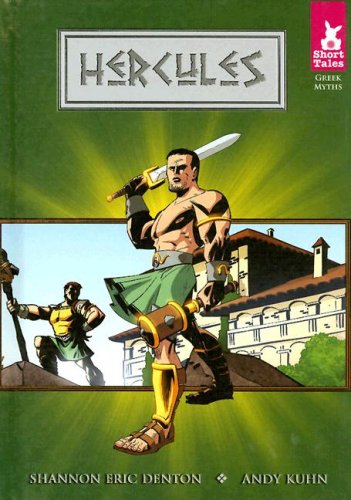Title of the work
Country of the First Edition
Country/countries of popularity
Original Language
First Edition Date
First Edition Details
Shannon Eric Denton, Hercules, ill. Andy Kuhn. Minneapolis: Abdo Consulting Group, 2008, 32 pp.
ISBN
Genre
Adaptations
Myths
Picture books
Target Audience
Children (age 5–8)
Cover

Permission to use the photo is granted by Paul Abdo, abdobooks.
Author of the Entry:
Zoia Barzakh, Bar-Ilan University, zoia_barzakh@mail.ru
Peer-reviewer of the Entry:
Lisa Maurice, Bar-Ilan University, lisa.maurice@biu.ac.il
Elizabeth Hale, University of New England, ehale@une.edu.au

Shannon Eric Denton (Author)
Shannon Eric Denton is an American veteran storyteller and artist who lives and works in Los Angeles, California.
Denton’s favourite genre is comics. He started in 1992 as an artist for Image Comic's Extreme Studios and authored dozens of popular comics’ series, including Spawn (1992), Big Bang Comics (1996) Deadpool (1997), and Big Game (1999). In 2000 he became a co-founder of Komikwerks, an independent comic publishing entity. He is a main writer of such Komikwerks series, as Nuts and Bolts (2004), Rockets & Robots (2005) and Thrills & Chills (2005). Among comics he authored are also Grunts (2006), Graveslinger (2007) and Outlaw Territory (2009).
From 1995–1999 Denton contributed to the design of plenty of series produced by the Fox Kids Network, including X-Men, Spider-Man and Silver Surfer.
He is a storyboard artist of several famous animated cartoons, including Oscar-nominated Jimmy Neutron: Boy Genius (2001) and Emmi-nominated Ozzi and Drix (2004–2006).
Denton has also worked in the games industry on titles such as God of War and Neo-Pets.
Awards: Readers’ Choice Red Kryptonite Award for Favorite New Creator (2001), Shel Dorf Award for Editor Of The Year (2011).
Source:
Personal website (accessed 06.09.2018).
Bio prepared by Zoia Barzakh, Bar-Ilan University, zoia_barzakh@mail.ru
Summary
This is a retelling of the myth of Hercules’ 12 labours, aimed at children learning to read. The book is one of six books that form Short Tales Greek Myths series, which is aimed for children reading. The series is described in the editor’s website as “easy-to-read books to children in the hopes that they will acquire a love of reading that will last a lifetime”. So, the main purpose of the book is the educational one: to help small children in learning to read. This purpose evidently shapes the style of the book, which is extremely simple.
The book started with the illustrated list of Greek gods.
Analysis
The language of the book is very simple, which is perfectly explainable by the fact that the book is aimed for the beginner reader. Consider the following examples of the style: “The second labor was to defeat nine-headed Lernean Hydra. The Hydra was a monstrous serpent. Its nine heads attacked with venom” (p. 7). Or: “Hercules continued on his quest. He was stopped by Antaeus, the son of the sea god Poseidon, and was forced to fight with him. Hercules won and continued on his journey” (p. 26).
As can be seen from these examples, the style of the book is shaped by its target audience and by didactic purpose, namely the development of basic reading skills in children who still lack them. The same can be said on the selection of the myth. This is limited to twelve labors of Hercules, with very short summary of background information, given in the chapter “Mythical Beginnings” (p. 4). Here the target audience shapes the narrative more than in any other chapter of the book. Consider, for example, the following retelling of the famous episode of the hero’s insanity: “Hera hated Hercules and used her powers to make him go insane. While under her spell, Hercules did some terrible things”. Neither the causes of Hera’s wrath nor the exact nature of those “terrible things” are told – obviously due to the fact that the authors want to spare children from gruesome or “adults-only” details of the original myth. The same technique of reservation is used several times in the middle of the story. E.g.: “Hera played trick on Amazons and Hercules. This trick got both sides to fight each other.” (p. 19).
The style of illustrations by Andy Kuhn is also shaped by the choice of target audience: all the characters there look strikingly similar to the characters of Japanese comics. Even Hercules lacks his famous beard and looks like anime hero. The illustrations often depict the most violent moments of the episode and are full of movement, bright colors and details.
The toponym “Mycenae” is frequently misprinted as “Mycenea” (pp. 11, 12, 17, 28, 32).
Copyrights
Illustrations by Andy Kuhn.


